Sonja Tsypin
Born: New York City, NY / Living: Los Angeles, CA
Interview by Lily Seckendorf — August 2018
Lily Seckendorf: How did you first get into cinematography?
Sonja Tsypin: I came into cinematography from a background in fine arts—I was a painter most of my life. I actually started out in documentary filmmaking, but eventually I began to crave more creative control over the content; I wanted to create stories from scratch. Finally, it became clear to me that my real passion lies in image-making more than anything else, and that’s how I found my calling in cinematography. Things haven’t changed all that much since my days of painting—I still work with composition, light, and color. I’ve just found a new medium.
LS: Do you prefer film over digital? How do you think they compare when it comes to the film’s connection with the audience?
ST: Of course there are considerable visual distinctions in the footage when shooting film as opposed to digital, including differences in color rendition, highlight, and shadow processing, homogenous vs. organic texture, etc. Ultimately, however, I believe the decision to shoot one over the other should depend on the demands and intentions of a particular story or concept, and though film can look really beautiful, that doesn’t mean it’s right for every project.
LS: You started out as a painter. Why did you choose to pursue cinematography over painting, and how does your experience as a painter relate to your career as a cinematographer?
ST: I think my background in painting informs what I do immensely. The biggest difference between the world of fine arts and the film industry, for me, is intention; I think filmmakers are much more aware of the audience and of the viewer’s experience, which is important. In the art world, you can make art for the sake of art. You make something just because it was stuck in your head and you had to get it out somehow. I’m glad I got to experience that before I came into this industry, because it taught me how to listen to my voice and not focus solely on reaction.
LS: Your works are quite narrative. What inspires you, and how do the plots develop in your mind?
ST: I do work on a lot of narrative projects—I think this has to do with my experience at the American Film Institute (AFI) which is an entirely narrative-based program where they teach that everything stems from story. I have done a bit of screenwriting, but I generally come onto a project a little bit further into the process once the script is finished or close to being finalized. From that point I do a lot of analysis during which I break down the script and try to understand what the essence of the story is. I work closely with the director, trying to uncover and understand their vision so that I can help bring it to life, and hopefully enhance it. I work to discover answers to questions like: what do these characters want? When are the biggest shifts in the script? What are the moments of decision? What’s the overall mood and tone of the piece? From there you can start to build a world, and a visual language grows out of that. Eventually, through that intimate collaboration, more elements can start to solidify including shooting format, lighting schemes, camera placement, movement, aspect ratio, etc.
LS: What lessons have you learned along the way?
ST: Don’t wait for anything or anyone to hand you an opportunity, just start creating content and that process will lead you forward. Even if a project feels in some way familiar, always work to find something in it that’s new to you—don’t settle for regurgitated concepts and stories. Push for risk-taking, otherwise why do what we do? Let your work speak for itself.
LS: Would you say your work is activist?
ST: My main aim is to tell stories and to create visuals that allow people to see things in a new light. I think our world is much more strange and surreal than it may seem, and as filmmakers we have the power to illuminate that magic in the mundanity. So in a way, I do want to change people’s minds, but not always towards an activist agenda. I think I’m more in the business of making art for art’s sake, but I do believe it’s absolutely possible for social change to be brought about through that art, whether intentionally or not, and that’s a beautiful thing.
Sonja Tsypin is a filmmaker based in Los Angeles, CA.

